Inspired by the US-based Intel Corporation’s founder chairman Craig Barrett, who practices American-style philanthrophy in its pristine form globally, during the past decade Intel India has introduced several technology-driven solutions which have sparked a teaching-learning revolution in Indian education. Dilip Thakore reports
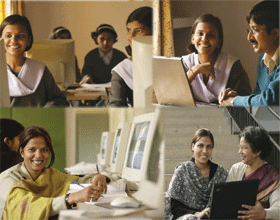 Within the placid 35-acre campus of Intel Technologies India Pvt. Ltd (Intel India) on Bangalore’s busy Outer Ring Road — a business enterprise that has made perhaps the most sustained and valuable contribution to the development and contemporisation of Indian education — excitement is building up as the company approaches a historic milestone.
Within the placid 35-acre campus of Intel Technologies India Pvt. Ltd (Intel India) on Bangalore’s busy Outer Ring Road — a business enterprise that has made perhaps the most sustained and valuable contribution to the development and contemporisation of Indian education — excitement is building up as the company approaches a historic milestone.
Some time next month (November), the number of K-12 pre-service, in-service, teacher educators and student teachers trained to use new, 21st century ICT (information communication technologies) by Intel India under its Intel Teach program kickstarted countrywide in the millennium year, will cross the psychologically elevating figure of 1,000,000. This is an unprecedented achievement in the history of corporate India bearing in mind that the total teacher population of India is 7 million; that Intel’s teacher training programme is delivered entirely free of charge mainly to government school teachers; and that it is company policy to train every teacher for a minimum of 60 hours (unlike some for-profit corporates who include teacher participation in seminars and 10-minute ICT training programmes in their impressive teacher training score cards). Unsurprisingly Intel India’s 2,600 employees are clearing the decks for some major celebrations to mark this milestone event this winter.
 “Intel is enhancing the lives of people — particularly teachers and students — in over 50 countries around the world by familiarising them with contemporary information communication techno-logies. For this purpose our parent company and its subsidiaries spend $100 million (Rs.450 crore) annually to create awareness of the benefits of ICT, and to make teachers and students around the world comfortable with these enabling technologies. In India we have been making efforts for almost a decade to introduce ICT into the country’s classrooms to enable a smooth transition into experiential and project-based learning. Our system-wide involvement with Indian education has resulted in the training of over 900,000 K-12 teachers under the Intel Teach Program; provision of ICT-enabled supplem-entary education to an estimated 57,000 out-of-school and under-served children; promotion of science education in secondary schools and encourage-ment of research and technology-driven entrepreneurship in higher education,” says Dr. Praveen Vishakantaiah, the Bangalore-based president and chief executive of Intel India.
“Intel is enhancing the lives of people — particularly teachers and students — in over 50 countries around the world by familiarising them with contemporary information communication techno-logies. For this purpose our parent company and its subsidiaries spend $100 million (Rs.450 crore) annually to create awareness of the benefits of ICT, and to make teachers and students around the world comfortable with these enabling technologies. In India we have been making efforts for almost a decade to introduce ICT into the country’s classrooms to enable a smooth transition into experiential and project-based learning. Our system-wide involvement with Indian education has resulted in the training of over 900,000 K-12 teachers under the Intel Teach Program; provision of ICT-enabled supplem-entary education to an estimated 57,000 out-of-school and under-served children; promotion of science education in secondary schools and encourage-ment of research and technology-driven entrepreneurship in higher education,” says Dr. Praveen Vishakantaiah, the Bangalore-based president and chief executive of Intel India.
An electronics and communications engineer from NIT Trichy and the University of Texas at Austin, Vishakantaiah signed up with Intel, USA in 1993 as a microprocessor designer, relocated to India in 2003 and was appointed president of the multinational corporation’s Indian subsidiary last year.
 Although the motives and aspirations behind Intel Corporation’s heavy involvement with Indian education undoubtedly sticks in the collective throat of ideologues of India’s communist parties and leftists who have massively infiltrated Indian academia, inspired by the US-based Intel Corporation’s founder chairman and chief executive Craig Barrett who practices American style philanthropy in its pristine form globally, during the past decade Intel India has introduced several technology-driven solutions which have sparked a teaching-learning revolution in Indian education. “We have the opportunity to create and cultivate knowledge and the capability to advance the social and economic well being — not only of individuals, but of nations,” Barrett told Intel India employees when he visited the company’s Bangalore headquarters in 2006. The Intel India management seems to have taken him at his word.
Although the motives and aspirations behind Intel Corporation’s heavy involvement with Indian education undoubtedly sticks in the collective throat of ideologues of India’s communist parties and leftists who have massively infiltrated Indian academia, inspired by the US-based Intel Corporation’s founder chairman and chief executive Craig Barrett who practices American style philanthropy in its pristine form globally, during the past decade Intel India has introduced several technology-driven solutions which have sparked a teaching-learning revolution in Indian education. “We have the opportunity to create and cultivate knowledge and the capability to advance the social and economic well being — not only of individuals, but of nations,” Barrett told Intel India employees when he visited the company’s Bangalore headquarters in 2006. The Intel India management seems to have taken him at his word.
Nevertheless intel india’s top brass is unwilling to disclose the ompany’s annual allocation for CSR (corporate social responsibility) activities, stating it is “well above Intel Corp’s global average”, i.e $2 million (Rs.9 crore) per country. However EducationWorld estimates it at $10 million (Rs.45 crore) per year, 95 percent of it spent on education development initiatives — a year-on-year investment in human resource development unmatched by any Indian corporate. Indeed Intel India’s whole-hearted commitment to its CSR activity centred around education enhancement and knowledge creation contrasts sharply with the primitive capital accumulation practices, or at best grudging ad hoc philanthropy of leaders of Indian industry. Although cynics ascribe Intel India’s commitment to its being an uncomplicated single product business enterprise — the company is focused on developing and manufacturing microprocessors and has resisted the temptation to diversify into related products and/or services — there’s no denying that its education focused CSR activities receive top level attention.
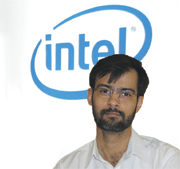 “In Intel companies around the world, we believe that CSR must necessarily be connected with our business activities, of which we have domain knowledge. Therefore there’s no denying that in the long run Intel India hopes to derive some business advantage as a consequence of our CSR programmes. In essence we are de-risking our business by building supportive communities whom we will have helped to absorb ICT to improve the quality of their lives. But while the main focus of our CSR activities is education development, we are also committed to environment protection and responsible corporate citizenship. Thus through continuous research effort we have transformed Intel into a chemicals and lead-free company, and have adopted advanced rainwater harvesting and energy saving practices in the cause of environment protection. Similarly we are fully committed to compliance with the strictest good corporate citizenship global norms in terms of employees’ conduct and employee volunteer programmes. For instance 80 percent of our employees have signed up for our Intel Teach and/or Intel Learn programmes under which they volunteer to teach in schools and teacher training institutes for a minimum of 20 hours. Their contribution is supplemented by monetary grants made by the company to the institutions where they teach, calculated according to the hourly remuneration of each volunteer,” says Rahul Bedi, an alumnus of the Delhi College of Engineering who signed up with Intel India in 2001 and is currently director of corporate affairs (South Asia) of the company.
“In Intel companies around the world, we believe that CSR must necessarily be connected with our business activities, of which we have domain knowledge. Therefore there’s no denying that in the long run Intel India hopes to derive some business advantage as a consequence of our CSR programmes. In essence we are de-risking our business by building supportive communities whom we will have helped to absorb ICT to improve the quality of their lives. But while the main focus of our CSR activities is education development, we are also committed to environment protection and responsible corporate citizenship. Thus through continuous research effort we have transformed Intel into a chemicals and lead-free company, and have adopted advanced rainwater harvesting and energy saving practices in the cause of environment protection. Similarly we are fully committed to compliance with the strictest good corporate citizenship global norms in terms of employees’ conduct and employee volunteer programmes. For instance 80 percent of our employees have signed up for our Intel Teach and/or Intel Learn programmes under which they volunteer to teach in schools and teacher training institutes for a minimum of 20 hours. Their contribution is supplemented by monetary grants made by the company to the institutions where they teach, calculated according to the hourly remuneration of each volunteer,” says Rahul Bedi, an alumnus of the Delhi College of Engineering who signed up with Intel India in 2001 and is currently director of corporate affairs (South Asia) of the company.
According to Bedi, apart from direct interventions of Intel India in teacher training, facilitating supplementary education for school students and encouraging curriculum development and research in institutions of higher education (see box p.38), the company is also engaged in several invisible “underwater” CSR activities to prepare the ground for absorption of technology aided learning systems in schools and colleges. “This requires us to engage with government education officials, organisations such as NCTE (National Council for Teacher Education), the Union government’s department of science and technology, as also with accreditation agencies such as NAAC (National Assessment and Accreditation Council). Our objective is to accelerate the scientific temper in Indian education, and to this end we sincerely believe that the application of ICT to teaching-learning processes will help India’s schools and colleges to leapfrog from teacher-centric to student-centric learning, and from current content delivery and assessment pedagogies to creating new knowledge,” says Bedi.
 To be sure, such statements of grand intent to invest in the development of the country’s massive human resource base — 450 million Indians are below the age of 18 — neglected by archaic and indifferent government designed and provided education, are often made by industry leaders and spokespersons. Yet despite the ground reality that Indian industry is the largest end user of educated and skilled youth, India Inc’s involvement with education development has been inadequate. The generous philanthropy and huge contributions made to Indian education by pre-independence titans of industry such as J.N. Tata who funded the Indian Institute of Science, Bangalore; G.D. Birla (Birla Institutes of Technology in Pilani, Ranchi and Mesra) and Lala Shri Ram (Shri Ram School and Shriram College of Commerce, Delhi) have not been matched by generation next in Indian industry. Consequently with the Indian economy having recently broken out of the cycle of the “Hindu rate” of annual GDP growth (3.5 percent from 1950-1990), the India Inc growth story of the past two decades is threatened by a chronic talent crunch and massive wage inflation.
To be sure, such statements of grand intent to invest in the development of the country’s massive human resource base — 450 million Indians are below the age of 18 — neglected by archaic and indifferent government designed and provided education, are often made by industry leaders and spokespersons. Yet despite the ground reality that Indian industry is the largest end user of educated and skilled youth, India Inc’s involvement with education development has been inadequate. The generous philanthropy and huge contributions made to Indian education by pre-independence titans of industry such as J.N. Tata who funded the Indian Institute of Science, Bangalore; G.D. Birla (Birla Institutes of Technology in Pilani, Ranchi and Mesra) and Lala Shri Ram (Shri Ram School and Shriram College of Commerce, Delhi) have not been matched by generation next in Indian industry. Consequently with the Indian economy having recently broken out of the cycle of the “Hindu rate” of annual GDP growth (3.5 percent from 1950-1990), the India Inc growth story of the past two decades is threatened by a chronic talent crunch and massive wage inflation.
 It’s against this backdrop that Intel’s well-planned and sustained interventions in Indian education provide a blueprint and template for Indian industry to emulate. “The company’s involvement with Indian education spans a wide range of activities — teacher training with state governments, informal education delivered through village Akshaya centres and IT kiosks, supplementary education for government school students, involvement with teacher training colleges and NCTE, and our teacher educators working with 55 universities. All these services fall within the ambit of the company’s CSR activities and are provided free of charge. Our objective is to help teachers teach students how to acquire, deepen and create knowledge; develop enquiry-driven, engaged classroom environments which encourage learning through project assignments and improve learning outcomes,” says Anshul Sonak, a science and rural management graduate of Delhi University and the Institute of Rural Management, Anand, Gujarat, founded by the legendary Dr. Verghese Kurien, author of India’s astonishing and under-appreciated white (milk) revolution, in 1979. With corporate management experience in Core Healthcare, Crompton Greaves and NIIT (1999-2004), currently Sonak supervises the implementation of Intel’s education initiatives in South Asia.
It’s against this backdrop that Intel’s well-planned and sustained interventions in Indian education provide a blueprint and template for Indian industry to emulate. “The company’s involvement with Indian education spans a wide range of activities — teacher training with state governments, informal education delivered through village Akshaya centres and IT kiosks, supplementary education for government school students, involvement with teacher training colleges and NCTE, and our teacher educators working with 55 universities. All these services fall within the ambit of the company’s CSR activities and are provided free of charge. Our objective is to help teachers teach students how to acquire, deepen and create knowledge; develop enquiry-driven, engaged classroom environments which encourage learning through project assignments and improve learning outcomes,” says Anshul Sonak, a science and rural management graduate of Delhi University and the Institute of Rural Management, Anand, Gujarat, founded by the legendary Dr. Verghese Kurien, author of India’s astonishing and under-appreciated white (milk) revolution, in 1979. With corporate management experience in Core Healthcare, Crompton Greaves and NIIT (1999-2004), currently Sonak supervises the implementation of Intel’s education initiatives in South Asia.
Sonak readily concedes that Intel’s exemplary interventions in K-12 and higher education in India are not driven by mere philanthropy, but also by “long-term strategic business ecosystem development” objectives. “Improvement in the quality of education is vital for creation of knowledge societies. Intel’s growth and development is dependent upon the emergence of knowledge societies around the world, particularly in populous countries such as India and China. Their transformation into modern knowledge creation societies will benefit Intel in terms of skilled employees and customers. Therefore our initiatives in Indian education are driven by a spirit of long-term enlightened self interest,” says Sonak.
Intel’s long-term business development aspirations through the practice of enlightened capitalism are also frankly conceded by R. Ravichandran, the Chennai-based sales director (South Asia) of the company. Yet he takes pains to stress that the company’s philosophy is to prosper by building the prosperity of host communities through aiding the development of their education, research and innovation capabilities.
 “Although Intel builds great products, our customers in India number a mere 50 million in a society of 1 billion people. Therefore our prime objective is to expand the size of this high-potential market by making technology accessible to a larger number of people, and working with governments to equip teachers and students with the critical skills required in today’s knowledge economy. Our long-term goal is admittedly business development, but if we can showcase the productivity gains of ICT to government and encourage it to scale up connectivity, we will automatically achieve our business goals,” says Ravichandran.
“Although Intel builds great products, our customers in India number a mere 50 million in a society of 1 billion people. Therefore our prime objective is to expand the size of this high-potential market by making technology accessible to a larger number of people, and working with governments to equip teachers and students with the critical skills required in today’s knowledge economy. Our long-term goal is admittedly business development, but if we can showcase the productivity gains of ICT to government and encourage it to scale up connectivity, we will automatically achieve our business goals,” says Ravichandran.
Be that as it may, the missionary fervour of handsomely-remunerated Intel managers and employees is unlikely to impress the great majority of Left-influenced academics, still suffering a collective hangover from Marxist gobbledygook economics, and pathological suspicion of private philanthropy. They remain blissfully unaware of the reality that West Bengal (pop.80 million), where the Communist Party of India (Marxist) has ruled since 1977, is among the country’s most educationally backward states. Or that the other Marxist stronghold state of Kerala (pop.32 million) owes its much trumpeted high literacy and education attainments more to Christian church institutions than the pusillanimous efforts of communist parties which hog the credit. Therefore the testimonies of end-users — and the company’s management can produce case-loads of them — of Intel’s voluntary interventions in Indian education provide valuable insights on their efficacy.
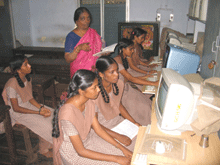 A secondary-cum-vocational school which has dramatically improved teaching-learning after 20 of its teachers were put through the Intel Teach program is the government-aided Tamil medium General Cariappa Higher Secondary School, Chennai (estb.1956). The school, which has an enrollment of 1,306 students instructed by 41 teachers, and offers vocational courses (refrigeration and air-conditioning repairs, auto mechanics, radio and television maintenance etc), was gifted ten PCs by the America India Foundation in 2002 and introduced to the Intel Teach program. “Intel trained master trainers taught our teachers the basics of computer usage, power point presentation, and how to do project-based research. Today our teachers have significantly enhanced their ICT knowledge, and have computerised operations such as mark sheets preparation, classroom ranking and annual results. We have also computerised our office administration operations. But perhaps most significantly, our students have learned to browse the internet, collect information and do project assignments. Learning outcomes have improved dramatically and a growing number of our students are being admitted into reputable polytechnics and Industrial Training Institutes,” affirms Thirumani Vaneetha, principal of the school.
A secondary-cum-vocational school which has dramatically improved teaching-learning after 20 of its teachers were put through the Intel Teach program is the government-aided Tamil medium General Cariappa Higher Secondary School, Chennai (estb.1956). The school, which has an enrollment of 1,306 students instructed by 41 teachers, and offers vocational courses (refrigeration and air-conditioning repairs, auto mechanics, radio and television maintenance etc), was gifted ten PCs by the America India Foundation in 2002 and introduced to the Intel Teach program. “Intel trained master trainers taught our teachers the basics of computer usage, power point presentation, and how to do project-based research. Today our teachers have significantly enhanced their ICT knowledge, and have computerised operations such as mark sheets preparation, classroom ranking and annual results. We have also computerised our office administration operations. But perhaps most significantly, our students have learned to browse the internet, collect information and do project assignments. Learning outcomes have improved dramatically and a growing number of our students are being admitted into reputable polytechnics and Industrial Training Institutes,” affirms Thirumani Vaneetha, principal of the school.
 The revolutionary impact of the Intel Teach program is also confirmed by Nafisa Bhinderwala, a science, education and sociology alumna of Bombay University and currently headmistress of the Children’s Academy, Kandivali, Mumbai, one of the three schools in the metro under the Children’s Academy umbrella with an aggregate enrollment of 10,000 students. “Since Intel introduced its Intel Teach program in our schools in 2000 — I was in the first batch of master trainees — all our 350 teachers who were earlier highly technophobic, have become ICT literate. The effect has been dramatic. Most of our students have become researchers and self-directed learners. Moreover even their extra-curricular activities — science, nature and HIV awareness clubs — are now technology driven. Learning outcomes have improved and so has the percentage of first-class students in board exams. Interest in self-learning has increased sharply and recently one of our students was awarded a full scholarship to the University of Auckland, New Zealand,” says Bhinderwala.
The revolutionary impact of the Intel Teach program is also confirmed by Nafisa Bhinderwala, a science, education and sociology alumna of Bombay University and currently headmistress of the Children’s Academy, Kandivali, Mumbai, one of the three schools in the metro under the Children’s Academy umbrella with an aggregate enrollment of 10,000 students. “Since Intel introduced its Intel Teach program in our schools in 2000 — I was in the first batch of master trainees — all our 350 teachers who were earlier highly technophobic, have become ICT literate. The effect has been dramatic. Most of our students have become researchers and self-directed learners. Moreover even their extra-curricular activities — science, nature and HIV awareness clubs — are now technology driven. Learning outcomes have improved and so has the percentage of first-class students in board exams. Interest in self-learning has increased sharply and recently one of our students was awarded a full scholarship to the University of Auckland, New Zealand,” says Bhinderwala.
Even within the somnolent groves of Indian academia, which seems to be entirely cut off from the problems of over 200 million children at the base of India’s iniquitous education pyramid, there is growing appreciation of the path-breaking role of Intel’s CSR interventions in Indian education. Among the ideologically unencum-bered academics in Indian higher education who are impressed with the company’s education development initiatives is Bangalore-based Dr. D. K. Subramaniam, an engineering post-graduate of Madras University with a doctorate in computer sciences from the highly-reputed Indian Institute of Science, Bangalore where he lectured for 40 years.
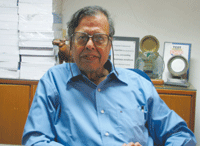 “In 2000, the Karnataka state government introduced its Mahatisindhu digital literacy programme by installing computer systems in 1,000 schools statewide. Since then over 25,000 government school teachers have been ICT trained under the Intel Teach program. This has had a very favourable impact upon the government school system in terms of higher student enrollment, student retention and learning outcomes. Moreover in collegiate education, Intel’s internet-based Reach to Teach, which is upgrading the skill-sets of teachers in engineering colleges countrywide, is proving very successful. Undoubtedly in the Indian context, the Intel India management through its dedicated and focused approach to education improvement has taken CSR activity to the next level, and has provided a good example to Indian industry,” says Subramaniam.
“In 2000, the Karnataka state government introduced its Mahatisindhu digital literacy programme by installing computer systems in 1,000 schools statewide. Since then over 25,000 government school teachers have been ICT trained under the Intel Teach program. This has had a very favourable impact upon the government school system in terms of higher student enrollment, student retention and learning outcomes. Moreover in collegiate education, Intel’s internet-based Reach to Teach, which is upgrading the skill-sets of teachers in engineering colleges countrywide, is proving very successful. Undoubtedly in the Indian context, the Intel India management through its dedicated and focused approach to education improvement has taken CSR activity to the next level, and has provided a good example to Indian industry,” says Subramaniam.
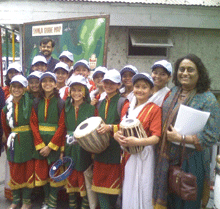 Against this backdrop of Intel India’s determined and sustained effort to engage with public education with commendable measurable results, it’s hardly surprising that traditional resistance to corporate private sector engagement with government schools and institutions of higher education is melting away. “Intel’s education initiatives are supported by the Central and state governments in India and by governments the world over. We have no hesitation about partnering with education departments, policy formulators and state governments to drive educational transformation. Over the years we have been accepted as trusted partners by governments and educators, and our programmes are executed as joint deliverables with strong government support. We have received numerous awards from state governments for whom we have conducted training programmes, and we keep getting requests to scale them wider and deeper. We certainly haven’t experienced any hostility to our education initiatives,” says Valsa Williams who as the Delhi-based head of Intel India’s corporate affairs group (government and north-east) supervises the company’s relationship with the Central and state governments.
Against this backdrop of Intel India’s determined and sustained effort to engage with public education with commendable measurable results, it’s hardly surprising that traditional resistance to corporate private sector engagement with government schools and institutions of higher education is melting away. “Intel’s education initiatives are supported by the Central and state governments in India and by governments the world over. We have no hesitation about partnering with education departments, policy formulators and state governments to drive educational transformation. Over the years we have been accepted as trusted partners by governments and educators, and our programmes are executed as joint deliverables with strong government support. We have received numerous awards from state governments for whom we have conducted training programmes, and we keep getting requests to scale them wider and deeper. We certainly haven’t experienced any hostility to our education initiatives,” says Valsa Williams who as the Delhi-based head of Intel India’s corporate affairs group (government and north-east) supervises the company’s relationship with the Central and state governments.
Quite clearly, if the positive response of teachers, academics, governments and students to the numerous and diverse Intel initiatives in Indian education is an indicator, the Bangalore-based company’s involvement with Indian education is likely to widen and deepen. Yet it’s important to remember that in the final analysis, Intel Corporation and its Indian subsidiary are commercial enterprises with a greater duty of care towards their shareholders; and that their capability to reform and contemporise India’s moribund education system is limited.
Nevertheless despite the company’s commercial orientation and perhaps extra-territorial loyalty and accountability, by applying the best practices and processes of corporate management, Intel India’s top brass has designed a tried and tested education development template for India Inc — which despite being the biggest ‘consumer’ of well-educated and skilled citizens has hitherto been content to pay lip service to education upgradation — to emulate.
Will the leaders of corporate India replicate and multiply the Intel model and meaningfully engage with Indian education to develop the country’s abundant but woefully under-developed human resources? The country’s superpower aspirations hinge on the answer to this question.
With Hemalatha Raghupathi (Chennai)